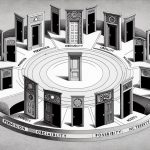You may have heard that no machine can be 100% efficient, but have you ever wondered why?
In this article, we will delve into the reasons behind this universal truth and explore the implications it has for our daily lives.
To understand why no machine can be 100% efficient, we must first understand the Laws of Thermodynamics. These laws dictate that energy cannot be created or destroyed, only transformed from one form to another.
As a result, every time energy is converted, some of it is lost in the process. This energy loss can occur in various ways, such as through heat, friction, or sound.
These losses ultimately limit the efficiency of machines and prevent them from achieving 100% efficiency.
Table of Contents
Understanding the Laws of Thermodynamics
You can’t escape the laws of thermodynamics, so no machine can ever be 100% efficient. These laws govern the behavior of energy in our universe, and they tell us that energy cannot be created or destroyed, only transformed. This means that when we use energy to power a machine, some of that energy is always lost in the form of heat.
The second law of thermodynamics is particularly relevant here. It states that the total entropy (or disorder) of a closed system will always increase over time. In other words, any process that involves energy transfer will result in some energy being lost to the environment.
This is why even the most efficient machines, such as solar panels or electric cars, cannot convert all of the energy they receive into useful work. Furthermore, the inefficiency of machines is not just due to the laws of thermodynamics. There are also practical limitations to how well we can design and manufacture them. Friction, resistance, and other physical factors all contribute to energy loss.
So while we can certainly strive to make machines as efficient as possible, we can never completely eliminate the wastage of energy.
Sources of Energy Loss
One of the biggest culprits of wasted energy is the friction between moving parts. No matter how well-designed a machine is, there will always be some level of friction that causes energy loss. This is because when two surfaces rub against each other, some of the energy is converted into heat and sound. This energy is lost and cannot be used to power the machine.
Another source of energy loss is due to the imperfections in the materials used to construct the machine. Imperfections in the materials can lead to energy loss due to the same mechanism as friction. The energy that is lost in this way cannot be recovered and is wasted.
Energy loss can also occur due to inefficiencies in the conversion of energy from one form to another. When energy is converted from one form to another, some of the energy is lost due to inefficiencies in the process. This can happen, for example, when electrical energy is converted to mechanical energy, or when heat energy is converted to electrical energy.
Types of Machines
There are various kinds of machines, each designed to perform a specific task with a unique mechanism. Some machines are simple, like levers and pulleys, while others are complex, like engines and turbines. However, no matter the complexity of the machine, they all have one thing in common: they can’t be 100% efficient.
The reason why no machine can be 100% efficient is due to the laws of thermodynamics. The first law states that energy can’t be created or destroyed, only transferred or transformed. This means that some energy will always be lost in the form of heat, sound, or friction. The second law states that the total entropy of a closed system will always increase over time. In other words, the disorder of a system will always increase, resulting in energy being lost as unusable heat.
Even though machines can’t be 100% efficient, engineers and designers strive to make them as efficient as possible. This is done by minimizing energy losses through various methods such as reducing friction, improving insulation, and using better materials. By making machines more efficient, we can reduce energy waste and increase productivity.
Efficiency vs. Effectiveness
When it comes to machines, it’s important to understand the difference between efficiency and effectiveness.
Efficiency refers to how well a machine uses energy and resources to perform a task. A machine is considered efficient if it uses as little energy and resources as possible to complete a task.
Effectiveness, on the other hand, refers to how well a machine performs a task. A machine is considered effective if it can perform a task accurately and reliably.
It’s important to note that a machine can be efficient but not effective, or effective but not efficient. For example, a machine that uses very little energy and resources to perform a task may be considered efficient, but if it doesn’t perform the task accurately or reliably, it’s not effective.
On the other hand, a machine that’s very good at performing a task accurately and reliably may not be considered efficient if it uses a lot of energy and resources to do so.
The reason why no machine can be 100% efficient is because of the laws of thermodynamics. The second law of thermodynamics states that energy is always lost when it’s converted from one form to another. This means that some of the energy that a machine uses will be lost as heat, sound, or other forms of energy. No matter how efficient a machine is, it will always lose some energy in the form of waste heat.
Impact on Daily Life
You can see the impact of efficiency and effectiveness in your daily life through the energy-saving appliances and reliable technology that you use every day. By using these appliances, you are able to save money on your energy bills and reduce your carbon footprint. For example, energy-efficient light bulbs use less electricity and last longer than traditional incandescent bulbs, which means you save money on your electricity bill and produce less waste.
Moreover, effective technology has made communication and information more accessible than ever before. Social media platforms allow you to stay connected with friends and family from all over the world, while search engines provide you with instant access to vast amounts of information. With the help of reliable technology, you can work remotely, attend virtual classes, and even access healthcare services from the comfort of your own home.
However, it is important to remember that no machine can be 100% efficient. This is because all machines require energy to operate, and some energy is always lost as heat or sound. While technology has certainly improved our daily lives, it is important to use it responsibly and consider its impact on the environment. By choosing energy-efficient appliances and reducing our consumption, we can all do our part to create a more sustainable future.
| Pros | Cons | Emotions evoked | ||
|---|---|---|---|---|
| Saves money on energy bills | Some energy is always lost as heat or sound | Optimism | ||
| Provides instant access to information | Can be addictive and lead to distraction | Excitement | ||
| Allows for remote work and virtual communication | Can create a disconnect from the physical world | Connectedness | ||
| Reduces carbon footprint | Can be harmful to the environment if not used responsibly | Responsibility | Overall impact depends on how it is used and the balance between benefits and drawbacks. |
Improving Machine Efficiency
If you want to improve machine efficiency, there are a few key things you can do.
First, consider using renewable energy sources to power your machines. This will not only reduce your carbon footprint but also save you money in the long run.
Second, make sure to reduce friction and wear by using high-quality lubricants and materials.
Finally, don’t forget about maintenance and upkeep – regular check-ups and repairs can prevent costly breakdowns and keep your machines running smoothly.
Using Renewable Energy Sources
Using renewable energy sources is essential in reducing carbon emissions and increasing efficiency in the long run. By utilizing energy sources such as wind, solar, and hydro power, machines can become more sustainable and environmentally friendly. This not only benefits the planet but also saves costs in the long term by reducing reliance on non-renewable energy sources.
To illustrate the impact of renewable energy sources, consider the following table:
| Energy Source | Carbon Emissions (g CO2/kWh) | Cost (USD/kWh) |
|---|---|---|
| Coal | 820 | 0.06 |
| Natural Gas | 490 | 0.05 |
| Wind | 11 | 0.03 |
| Solar | 45 | 0.12 |
| Hydro | 24 | 0.07 |
As shown in the table, renewable energy sources such as wind, solar, and hydro power have significantly lower carbon emissions compared to non-renewable sources like coal and natural gas. Additionally, while the upfront cost of implementing renewable energy technology may be higher, the long term cost is much lower. By utilizing renewable energy sources, machines can not only become more efficient but also contribute to a more sustainable future.
Reducing Friction and Wear
Reducing friction and wear is crucial for extending the lifespan of machinery and minimizing the need for frequent repairs or replacements.
Friction is the force that opposes motion between two surfaces in contact, and it results in the generation of heat which can cause wear and tear on the machinery.
One way to reduce friction is to use lubricants such as oils and greases, which create a thin film between the surfaces and reduce the direct contact between them. This not only reduces friction but also prevents wear and tear caused by metal-to-metal contact.
Another way to reduce friction and wear is to ensure that the machinery is properly aligned and balanced. Misalignment and unbalanced machinery can cause excessive vibrations which can lead to increased friction and wear.
Regular maintenance and inspections can help identify and correct these issues before they cause significant damage. By reducing friction and wear, you can not only extend the lifespan of your machinery but also improve its efficiency and reduce energy consumption.
So, it’s crucial to make sure that your machinery is properly lubricated, aligned, and balanced to achieve the best performance.
Maintenance and Upkeep
Proper maintenance and regular upkeep are essential for ensuring the longevity and optimal performance of machinery. Neglecting these tasks can lead to costly repairs and decreased efficiency. Here are some tips to help you maintain your machine:
- Keep the machine clean and free of debris and dust.
- Check and replace any worn or damaged parts regularly.
- Lubricate moving parts to reduce friction and wear.
- Follow the manufacturer’s recommended maintenance schedule.
- Train operators on proper usage and care of the machine.
By following these simple steps, you can help prolong the life of your machine and ensure it operates at peak performance.
Remember, investing time and resources into maintenance and upkeep now can save you money and headaches in the long run.
Looking to the Future
Innovation will drive the machines of tomorrow towards higher efficiency, bringing us closer to the elusive goal of 100% efficiency.
With advancements in technology, we can expect to see machines that use renewable energy sources, such as solar and wind power. This move towards clean energy will not only make machines more efficient, but also reduce their carbon footprint, making them more environmentally friendly.
Additionally, new materials and designs will allow for machines to operate at higher temperatures and pressures, increasing their efficiency. For example, new alloys and coatings can help reduce friction and wear in engines, leading to less energy loss and improved performance. Similarly, 3D printing technology can be used to create intricate and lightweight parts, reducing the overall weight of machines and making them more energy-efficient.
However, despite these advancements, it’s unlikely that any machine will ever achieve 100% efficiency. This is because of the fundamental laws of thermodynamics, which dictate that all machines will experience some degree of energy loss due to heat transfer.
Nevertheless, the pursuit of higher efficiency remains an important goal, as it can lead to significant cost savings and reduce our dependence on non-renewable energy sources.
- Can You Use a Razor to Remove Fabric Pilling? Is It Safe? - June 10, 2025
- What Causes Pilling on Bed Sheets and How Can I Avoid It? - June 10, 2025
- How to Prevent Pilling on Blended Fabrics Like Cotton-Poly? - June 10, 2025





